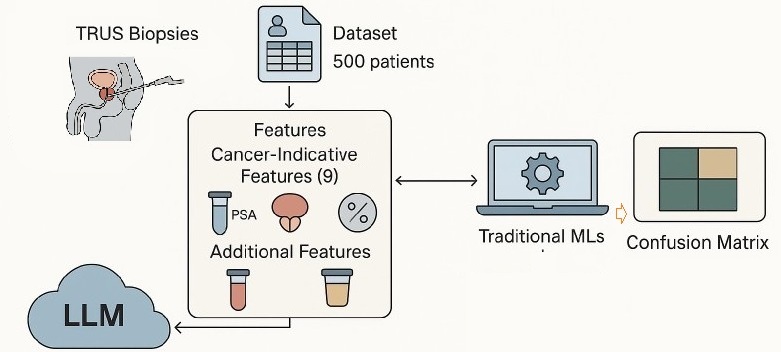Empowering prostate cancer care with LLMs: A new era of accurate diagnosis

DOI:
https://doi.org/10.62110/sciencein.jist.2025.v13.1171Keywords:
Prostate Cancer Detection, , Machine learning models, Cancer-Indicative Features, LLMs.Abstract
This study examines the application of Artificial Intelligence (AI), particularly Large Language Models (LLMs), in diagnosing prostate cancer using data from 500 patients who underwent Transrectal Ultrasound-Guided Biopsies (TRUS Bx) at Jordan University Hospital between 2007 and 2024. The dataset comprises 21 clinical features, including 9 indicators of cancer (e.g., total PSA, free PSA, prostate volume) and 12 additional exploration features (e.g., blood and urine metrics). We compared the performance of traditional machine learning models (Logistic Regression, SVM, KNN, XGBoost) with advanced LLMs, including Mistral-7B, Zephyr 7B, and Phi 3 Medium 4K Instruct. Traditional models achieved moderate accuracy (81.0%–83.6%), while LLMs demonstrated higher performance, all surpassing 93% accuracy. Mistral-7B achieved the highest at 94.5%. Confusion matrix analyses confirmed the advantages of LLMs in terms of precision, recall, and reduced misclassification. These results highlight the potential of LLMs to identify complex clinical patterns that conventional models may overlook. However, considerations regarding computational cost and model interpretability are crucial for real-world clinical applications. This research highlights the transformative potential of generative AI in prostate cancer diagnosis, laying the groundwork for future studies to expand feature sets and improve diagnostic accuracy.
Downloads
Downloads
Published
Issue
Section
URN
License
Copyright (c) 2025 Adel Alrabadi, Mohammad Alshraideh, Bahaaldeen Alshraideh, Abedalrahman Alshraideh, Lara Shboul, Ayah Karajah, Bayan Alfayoumi

This work is licensed under a Creative Commons Attribution-NonCommercial-NoDerivatives 4.0 International License.
Rights and Permission







